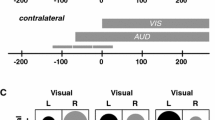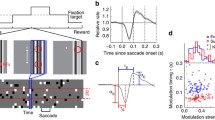Abstract.
Saccadic reaction times to visual targets tend to be faster when non-visual stimuli are presented in close temporal or spatial proximity even if subjects are instructed to ignore the accessory input. The effect tends to decrease with increasing spatial distance between the stimuli. Multisensory interaction effects measured in neural structures involved in saccade generation have demonstrated a similar spatial dependence. The present study investigated visual-tactile interaction effects on saccadic reaction time using a focused attention paradigm. Compared to unimodal visual targets saccadic reaction time to bimodal stimuli was reduced by up to 30 ms. The effect was larger for ipsi- than for contralateral presentations, and it increased with the eccentricity of the visual target. The results are consistent with attributing part of the facilitation to a multisensory effect of bimodal neurons with overlapping visual and tactile receptive field structures in the deep layers of the superior colliculus.
Similar content being viewed by others
Author information
Authors and Affiliations
Additional information
Electronic Publication
Rights and permissions
About this article
Cite this article
Diederich, A., Colonius, H., Bockhorst, D. et al. Visual-tactile spatial interaction in saccade generation. Exp Brain Res 148, 328–337 (2003). https://doi.org/10.1007/s00221-002-1302-7
Received:
Accepted:
Issue Date:
DOI: https://doi.org/10.1007/s00221-002-1302-7




